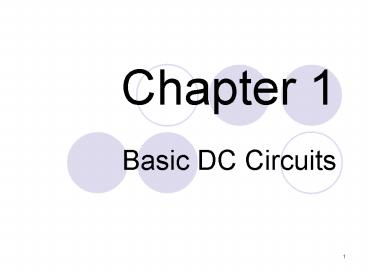Basic DC Circuits
1 / 46
Title:
Basic DC Circuits
Description:
Distinguish between dc and ac and discuss some of the basic properties of each. ... An Ammeter is Connected Within the Branch for Which Current is to be Measured. 20 ... –
Number of Views:2555
Avg rating:3.0/5.0
Title: Basic DC Circuits
1
Chapter 1
- Basic DC Circuits
2
Objectives
- Distinguish between dc and ac and discuss some of
the basic properties of each. - State and describe the basic circuit variables
including charge, voltage, current, power, and
energy. - Define resistance and conductance and show the
schematic symbol.
3
Objectives
- State the properties of the ideal voltage source
and ideal current source models and show their
schematic symbols. - State and apply Ohms law.
- Discuss voltage and current measurements and how
they are made. - State and apply Kirchoffs voltage law.
- State and apply Kirchoffs current law.
4
Objectives
- Determine equivalent resistance using series and
parallel combinations. - Analyze a single-loop (series) circuit to
determine all the variables. - Analyze a single node-pair (parallel) circuit to
determine all the variables. - State and apply the voltage divider rule.
- State and apply the current divider rule.
5
1-1 DC Circuit Variables
6
Comparison of a DC Voltage and an AC Voltage
7
Conventional Current Flow in Opposite Direction
to Electron Flow
8
Voltage Between Two Points in a Circuit
9
Schematic Symbols for an Ideal Voltage Source and
a Battery
10
Schematic Symbol for an Ideal Current Source
11
Schematic Symbol for a Resistance
12
Illustration of a Short Circuit and an Open
Circuit
13
1-2 A Very Simple DC Circuit
14
Simple Circuit Used to Illustrate Ohms Law
15
Different Types of Ground
16
Simple Circuit Redrawn with Ground Symbols
17
1-3 Measuring DC Circuit Variables
18
A Voltmeter is Connected Between Two Points in a
Circuit Across Which the Voltage is to be Measured
19
An Ammeter is Connected Within the Branch for
Which Current is to be Measured
20
1-4 Power and Energy
21
Reference Directions for Power Delivered
22
Reference Directions for Power Absorbed
23
1-5 Kirchoffs Laws
24
A Loop Used to Illustrate Kirchoffs Voltage Law
25
Illustration of Kirchoffs Current Law at a Node
26
Circuit of Example 1-8
27
Circuit of Example 1-9
28
1-6 Equivalent Resistance
29
Resistances in Series and the Equivalent Single
Resistance
30
Resistances in Parallel and the Equivalent Single
Resistance
31
Circuit of Example 1-10
32
Reduction of the Circuit of Example 1-10
33
1-7 Single-Loop or Series Circuit
34
Representative Single-Loop (Series) Circuit
35
Circuit of Example 1-11
36
Circuit of Example 1-12
37
1-8 Single Node-Pair or Parallel Circuit
38
Single Node-Pair (Parallel) Circuit
39
Representative Parallel Circuit with Current
Sources
40
Circuit of Example 1-13
41
Circuit of Example 1-14
42
1-9 Voltage and Current Divider Rules
43
Circuit Used to Illustrate the Voltage Divider
Rule
44
Circuit Used to Illustrate the Current Divider
Rule
45
Circuit of Example 1-15
46
Circuit of Example 1-16































